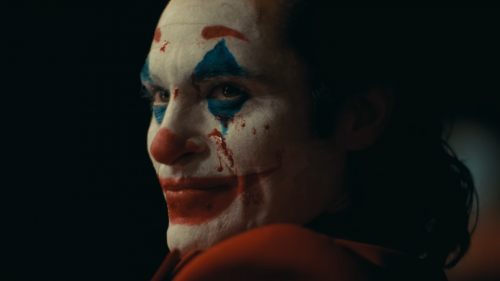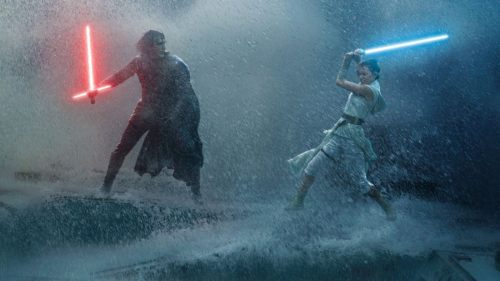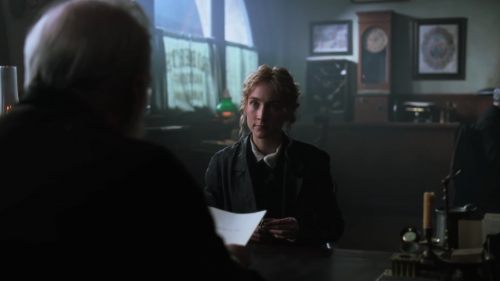RETURN OF THE JOKER: Mark Hamill’s Darkest, Finest Hour
Joker is in theaters now. Get your tickets here!
The Joker is a terrific villain. First created by Bill Finger, Jerry Robinson, and Bob Kane in 1940, the self-styled Clown Prince of Crime has proved an enduring and malleable fiend. He can be hilarious. He can be horrifying. He functions equally well as a direct foe or as an ideological opponent against whom Batman must bring all his skill and strength to bear. While the Joker may not always be the polar opposite of the Caped Crusader, he is reliably a striking foil.
Within the panels of Batman’s many comics, I’m particularly fond of the Frazer Irving-drawn and Grant Morrison-written Batman & Robin Must Die! – a three way bout pitting Dick Grayson and Damian Wayne’s Batman and Robin against a particularly cunning Joker and the sneering villain Doctor Hurt. Onscreen incarnations, of course, have pinballed everywhere from the late Heath Ledger’s nihilistic terrorist to Zach Galifianakis’ amiable wannabe frenemy and all points between.
But no conversation about the Joker can be complete without Mark Hamill. He first played the Ace of Knaves in 1992’s much-loved Batman: The Animated Series – the show that launched the DC Animated Universe – and 27 years on, he’s still at it, the single longest tenure of anyone to play the character. In that enormous body of work, I’d argue that the animated movie Batman Beyond: Return of the Joker – set in the high-tech future of the DCAU and starring Bruce Wayne (voiced by Kevin Conroy)’s successor Terry McGinnis (voiced by Will Friedle) – stands as his best performance of the character.
Return of the Joker follows the malevolent clown’s assault on Gotham in the late 2030s – somehow back in the game decades after his death. In the years since his demise, the Joker’s name and style have been co-opted by the Jokerz – a fractured collective of delinquents with a shared affection for gaudy, circus-inspired clothing. The Jokerz are, on their own terms, dangerous, though compared to the new Batman’s rogue’s gallery of bad guys, they’re decidedly small-time – they prefer thievery to mass-scale corruption, vengeful attempted murder, or mutation of all humankind into dinosaurs. Their low ambitions and comparative ineptitude embarrass the Joker, driving him to seize control of a faction and mold them into something more worthy of his name:
In this iteration, Hamill’s Joker begins with an ego the size of Jupiter and a contemptuous, seemingly unshakable certainty. He is the greatest person ever to live. He’s the smartest, the most daring, the best dressed. Those graced by his wisdom had best show proper deference. To be questioned is to be insulted. To be challenged is to be wronged. Any defiance must be answered with overwhelming force – but not before reminding his unfortunate foe (and anyone else in the room) that he stands above all.
Beyond just hubris, Hamill weaves a deep vein of genuinely disturbing cruelty into the Return Joker’s voice. Everything Joker says is aimed to hurt, and his beloved jokes are razor-edged zingers. Hamill turns Joker’s infamous laugh into a full-blown weapon, as when he mocked the first Batman on the night of their erstwhile final battle:
The final element that makes Hamill’s Return of the Joker performance an all-timer is quieter, but no less important. Underneath all of the Joker’s bombast and sadism, perhaps even unrecognized, lies a remarkably brittle man. There are hints of this in how personally he takes the Jokerz inadvertently dragging his bad name through the mud, and in the grotesque pantomime of a Nuclear Family Dad he uses to reveal his appalling final crime to Bruce Wayne’s Batman. But Hamill really brings it to the fore in the climax. Take a look and a listen to his final battle with Terry McGinnis’ Batman:
Hamill slips hints of Joker’s desperation into his boasts. When Joker talks about knowing “every trick the original Batman and Robin knew at their peak” and dismisses Terry as “a rank amateur,” Hamill’s voice wavers, just a tad. He speaks a little too quickly. He tries to puff himself back up as McGinnis’ Batman starts getting under his skin and picking his persona apart. Joker sincerely believes McGinnis is nothing compared to Bruce Wayne (who was himself nothing compared to the glory of Joker), but try as he might, he cannot tune out McGinnis’ scathing critiques. And when McGinnis is not only unmoved by Joker’s mind games but returns them in kind, laughing at him, Hamill drops any and all cool. His final, desperate attack on McGinnis is as much verbal brute force as it is physical. Whereas Joker could push Bruce Wayne’s buttons with a well-crafted barb, he can only scream at McGinnis, demanding that the young Batman laugh as Joker tries to strangle him. It’s both terrifying and, to quote both men, more than a little “pathetic.”
Hamill’s Joker is one of the most reliable performances in Western animation. His turn in Return of the Joker is both a fine example of that trend and a tremendous piece of acting on its own. He’s true to the character’s core even while performing some of the darkest material in the role’s history. His zingers land just as well as his moments of viciousness – and he can do both simultaneously. He grants Joker a loathsome, squirming humanity without tripping into making the arch-villain a romantic, Tyler Durdenesque figure. And his evil laugh is in top form.



